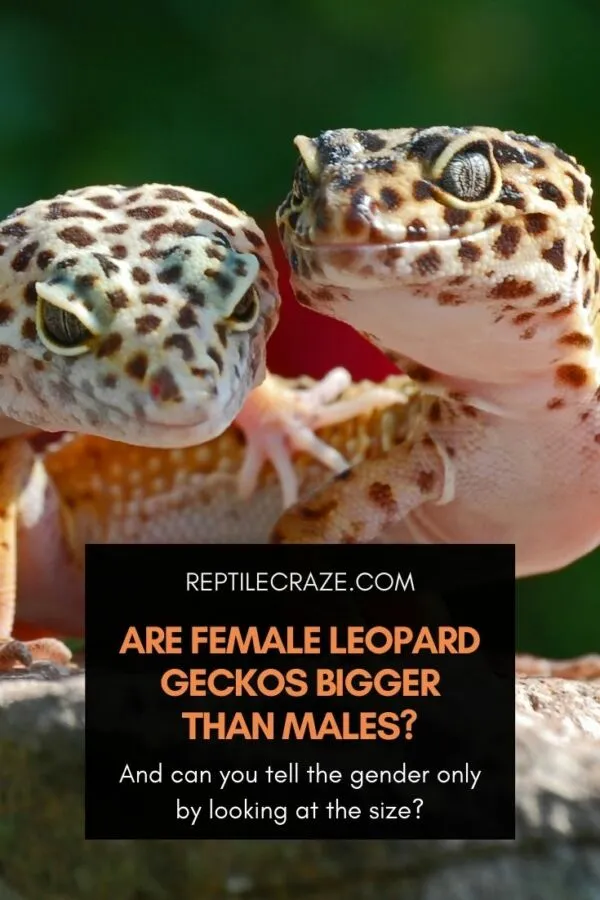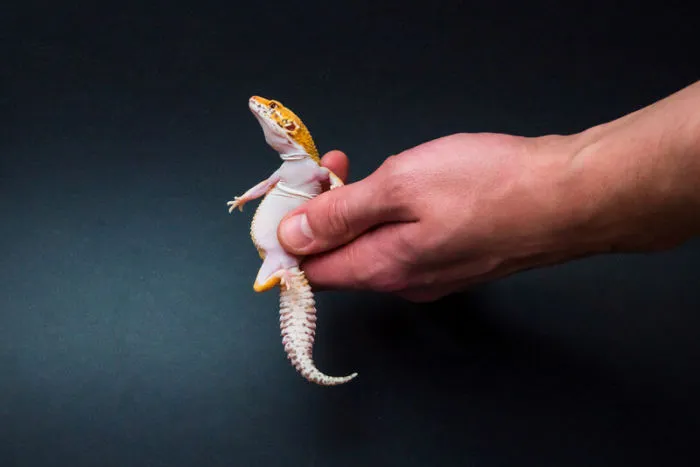
It can be very difficult to tell the difference between a male and a female leopard gecko. I’ve rehoused many of these amazing reptiles and on several occasions, the previous owners have been unable to tell me the animal’s sex. Knowing the sex of a leopard gecko helps you understand what to expect from your pet, and what changes you need to make to your setup to accommodate your lizard buddy correctly.
Female leopard geckos are smaller than males and grow to between 18cm – 20cm (7.1 – 7.9 inches) in length and 45g to 70g in weight. Male leopard geckos are longer, reaching a length of around 20cm to 28cm (7.9 – 11 inches). Male leopard geckos also weigh more, reaching upwards of 60g to 90g.
Let’s take a look at what makes female leopard geckos smaller and some of the other differences between males and females that are important to know as a pet owner. If you’re thinking of getting a leopard gecko or adding another to your
Table of Contents
Why are Male Leopard Geckos Bigger than Females?
Most desert lizards tend to have larger females than males, but leopard geckos are one species where this relationship is reversed. There are various theories as to why male leopard geckos are the larger of the two sexes, including:
Testosterone
This hormone increases body size in males and also increases territorial aggression, which male leopard geckos must have to compete with each other.
Species Aggression
While male leopard geckos are far more aggressive, females can be aggressive as well. Males have to be able to protect themselves from females who aren’t interested in their advances.
Egg Laying
Female leopard geckos can lay between 50 to 100 eggs throughout their lives. With a smaller body size, they can find more secluded and safer environments in which to lay eggs. They also may benefit from being able to hide more easily from predators such as foxes, snakes, and other reptiles.
Fitness Selection
This means that females are more likely to mate with males who will provide strong offspring. Male leopard geckos with larger heads are more readily accepted by females. This in turn means that their offspring is most likely to have these characteristics to aid competitiveness with other geckos.
Fecundity Selection
Females will also select mates most likely to provide larger numbers of viable offspring. Physical prowess in males has been linked to higher numbers of offspring in many lizard species.

Can You Tell a Female from a Male Leopard Gecko Only by Looking at the Size?
Size isn’t always the best way to differentiate between a male and female leopard gecko. There are two reasons for this:
- Occasionally a male gecko will be smaller than usual, and a female larger.
- Up until they reach adulthood, female and male leopard geckos are often the same size.
Let’s look now at some of the more reliable ways to identify the sex of your leopard gecko.
Pre-Anal Pores
It’s not nearly as unpleasant as it sounds. If you look at the underbelly of your leopard gecko, you can tell a lot about its sex. If you can find the “vent”, which is where your leopard gecko releases its faeces, look to see if it has any pores just in front of it.
If it’s a male, there should be a pretty obvious collection of pre-anal pores that are shaped like a V.
One caveat to this is that these pores become more pronounced as a leopard gecko matures, so don’t expect to see much of them until your gecko is about four months old.
Pro-Tip: Female leopard geckos have these pores as well! But they are much fainter and difficult to spot. If the pores are very visible, then it’s probably a male. If you’re still having doubts, look for a waxy substance coming out of the pores. This substance is used by the leopard gecko to mark its territory, and will only appear once the animal is sexually mature (about 10 months old).
Hemipenile Bulges
Another difference between male and female leopard geckos is that males have hemipenile bulges. These are the lizard’s reproductive organs. In essence, they are two penises (I was going to make a joke here, but… No…).
You’ll find the hemipenile bulges on the underside of the tail, just behind the vent. However, they may be tucked away and difficult to see.
Do not push the hemipenile bulges to try and see if the penises will extend, thereby letting you know if the animal is a male. This can cause a dangerous condition known as hemipenile prolapse. You might also cause your leopard gecko to feel it is being attacked, in which case it might drop its tail off as an escape tactic (yes they can do this).
Femoral Pores
Another way to check the sex of your leopard gecko is to look for femoral pores. These pores secrete pheromones to attract mates. They also act as a kind of ID card, letting the gecko identify itself to others (though I doubt it’s getting into a club with that kind of ID).
It’s good to know about these pores as they can actually get clogged up, which is something a vet might need to fix.
These pores can be found on the hind legs of males. You’ll find them on the underside of the legs in the thigh region. Look closely and you should see a row of white dots. That’s them! If you see them, it’s a boy!
You can also learn about the difference between female and male tail wagging, which is a dead giveaway to their sex in some instances as well.
Why is it Important to Know the Sex of a Leopard Gecko?
We all love learning about the reptiles we keep – it’s fascinating – but knowing the sex of your leopard gecko is more than a piece of interesting trivia: It makes you a better pet owner!
The sex of your leopard gecko will determine:
- How your
tank is set up. - Whether you can keep other leopard geckos in the same
tank . - What types of behavior to expect from your little lizard buddy.
The Dangers of Not Knowing A Leopard Gecko’s Sex
The most important thing to know here is that leopard geckos, as much as we love them, can be cantankerous little… I promised I wouldn’t swear while talking about this! But yes, your gecko can be super aggressive to other geckos in the same

Males are the worst offenders. With all that testosterone coursing through their veins, they do not make good roommates. Well, for other male geckos, at least. I know, someone is out there rolling their eyes at this as they read, saying “I keep two male leopard geckos together and they get on fine.”
Great! But that’s not the usual experience. They are very territorial and will bite each other when put into a confined space like a
Remember, they use their territory to compete for females, and the best way to do that is to ensure other male leopard geckos aren’t around! Even keeping males and females together is really only a good idea during the breeding season.
Can Female Leopard Geckos Live Together?
You’ll have much more luck housing two female leopard geckos together. They tend to be less aggressive
BUT:
Females can still attack each other.
The rule of thumb for keeping female geckos together is: They’ll get on fine if both have a more docile temperament and are of the same size. If you put an aggressive female in with another female, it can get messy very quickly.
Remember, even though leopard geckos have many predictable traits, they are still thinking creatures and can surprise us. Did you ever read about the guy who was eaten alive by a tiger he’d owned for twenty years?
Animals can change their behaviors just like people. Keep an eye out for any sudden changes in how your female leopard geckos are interacting.
Should You get a Male or Female Leopard Gecko?
If you’re looking to buy a leopard gecko, then you should think about what type of pet you want. Of course, there are no guarantees about animal health and behavior, but there are distinct advantages and disadvantages to owning either a male or female leopard gecko.
Advantages of Owning a Male Leopard Gecko
Males have a few traits that you might want to consider:
Changing Temperament: While male leopard geckos are generally more aggressive, they also are more consistent in their behavior from season to season. Females become more cautious during breeding season, sometimes resulting in extended periods of hiding and stress.
Age Span: Males can live as long as 25 years in some cases, but females only live to about 15 at the most. This is because female lizards tend to die once they can no longer reproduce. The constant cycle of fasting and laying eggs also takes its toll.
Handling: Because male leopard geckos are often more outgoing, especially during breeding season, they are much more eager to be held. If you are the type of pet owner who wants to handle your lizard regularly, this is worth bearing in mind.
Advantages of Owning a Female Leopard Gecko
Female leopard geckos also have their own set of characteristics that can make them an excellent choice as a pet:
Reproduction: It may sound obvious, but if you want to breed more leopard geckos, you’ll need a female.
Companionship: Female leopard geckos are more likely to be able to live with other leopard geckos, though usually females. Males and females are often only brought together during breeding. In a 40
Smaller Size: In some instances, female leopard geckos can be a third smaller than males. This can mean the animal gets more out of the same sized
Conclusion
I hope you’ve enjoyed this little discussion about female leopard geckos and why they are smaller than males. Owning leopard geckos is such a thrill, but people often overlook the sex of their pets and how this should factor into their setups.
Now, I have to go, my leopard gecko Ralf is due his mealworms and he gets cranky if he has to wait long. Such a diva.
- Enchi Ball Python: A Unique and Stunning Morph of Python regius - March 27, 2025
- Emerald Tree Monitor: The Enigmatic Green Guardian of the Rainforest - March 26, 2025
- The Egyptian Cobra (Naja haje): A Fascinating Serpent - March 25, 2025
